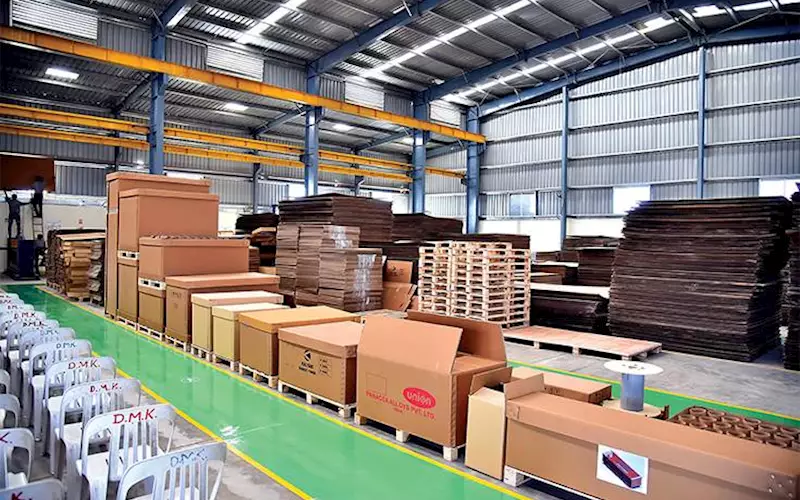Econovus and the art of sustainable packaging
The word ‘sustainability’ has become a very common topic of discussion among industries alike. In 1987, the United Nations Brundtland Commission defined sustainability as “meeting the needs of the present without compromising the ability of future generations to meet their own needs.” No wonder, leading responsible organisations are looking at newer ways of becoming more and more sustainable. In the automotive sector, while many see OEMs focusing on reduction in tailpipe emissions, there are many other factors being addressed behind the scenes, be it using clean energy to power factories, rainwater harvesting or even sustainable packaging.
21 Apr 2021 | By WhatPackaging? Team
While much has changed and improved in key areas, there is still a long way to go in the packaging industry. The Pune-headquartered Econovus Packaging aims to be a leading partner to enable the auto industry to switch to green packaging and further reduce its carbon footprint.
“Organisation vision with clear KRAs (Key Result Areas) and policy deployment need to be spelled out with a vision statement by top management ‘To achieve carbon neutrality by year . . . ’. There is a long-drawn process for reducing the carbon footprint based on a sustainability report looking at the entire supply chain. Packaging is one of the contributors to carbon emissions and among the challenges we see are awareness and willingness among customers to change from traditional ways of packaging to green packaging. Validation and lead time of changed packaging with reference to laboratory and RWUP testing (Real World Usage Pattern testing) especially for export is also delaying in implementation. I believe most automotive companies have already initiated work in this direction but this needs to percolate down to Tier-1 and Tier-2 companies and challenges remain here. Green initiatives should be one of the criteria for supplier selection and training and awareness to provide to existing suppliers,” explains Ramesh Prasad, founder and managing director, Econovus Packaging.
Econovus is a packaging engineering company and said to be among the fastest growing packaging company in India in the automotive and industrial space. The company enables 93 percent reduction in carbon footprint based on replacement of wooden packaging with eco-friendly lighter material. It is targeting to reach 100 percent by replacement of wooden pallet with its innovative ‘ESP Pallet’.
The solution also enables reduction in cost up to 15 percent through its unique engineering approach working in 3D environment to ensure best box optimisation and container optimisation using its inhouse state-of-art laboratory for raw material testing and final Compression testing. “Further, we have established a 10-step ENPDP (Econovus New Product Development process) to ensure FTR (First Time Right) product,” explains Prasad.
Reduction in packaging cost
As a manufacturing powerhouse, India is the world’s fourth largest automobile manufacturer and also one of the key exporters both in terms of vehicles as well as parts. In terms of key products, the most exported made-in-India automotive components include gearbox, engine, drive axles, suspension system, transmission, braking system, hydraulic system, wheels and BIW (Body in White) parts.
The annual expenditure of Indian automotive parts’ export packaging is estimated to be more than Rs 7,500 crore a year. Prasad says there is a “huge potential and scalability of export packaging as export business of automotive components is expected to reach $80 billion (Rs 592,080 crore) by FY2025-26 as per ACMA. Suppliers can reduce packaging cost based on our unique engineering ‘Design-to- Cost’ approach and cherry-pick the right eco-friendly material.”
The automotive supply chain works in an immense complex environment and finding the right balance of functionality and sustainability becomes an overarching challenge. “The continued focus on green supply chain and carbon neutrality, the role of packaging becomes utmost critical and challenging. Usage of sustainable packaging contributes to reduction of the carbon footprint by replacement of wooden and plastic material by alternate green material. Further, ensuring chain of custody and identifying areas within the company to reduce carbon footprint, based on carbon lifecycle assessment (LCA) and sustainability reports. The purpose of reducing the carbon footprint is to offset the existing emissions to support automotive companies’ plants carbon-neutral,” explains Prasad.
Reducing the carbon footprint
As is the case, digitalisation plays a key role in almost all industries, and the packaging industry is no different. Prasad says digital packaging has a huge role not only in box and container optimisation but overall management of container operations especially in automotive CKD operations. Smart or clever packaging solutions is the right usage of technology and packaging skills resulting in increased efficiency and ‘Pokayoke’, which is also called mistake proofing. Some of technology used is software design, simulation for optimisation and bar code, QR code, BLE technology for material tracking and inventory management.
Econovus also uses pallet-less packaging and paper pallet as some of the sustainable products where it completely replaces wood. “This not only reduces carbon but also reduces packaging and freight cost due to reduction in 40 percent weight. This is how we differentiate ourself from traditional packaging and other competitors. The wooden pallets, after their use, cannot be recycled and end up as landfill, whereas ESP pallets can be recycled reducing the burden on environment. The utilisation of ESP pallet of standard Euro size of 1200 x 800 x 150mm enables a carbon footprint reduction of upto 90.35 percent,” points out Prasad.
With sustainability as its overarching mission, Econovus aims to be a leading partner of choice for OEMs and suppliers looking to shed the kilos as well as reduce carbon footprint in their packaging solutions.
This feature was first published in Autocar Professional's April 1, 2021 issue.














 See All
See All